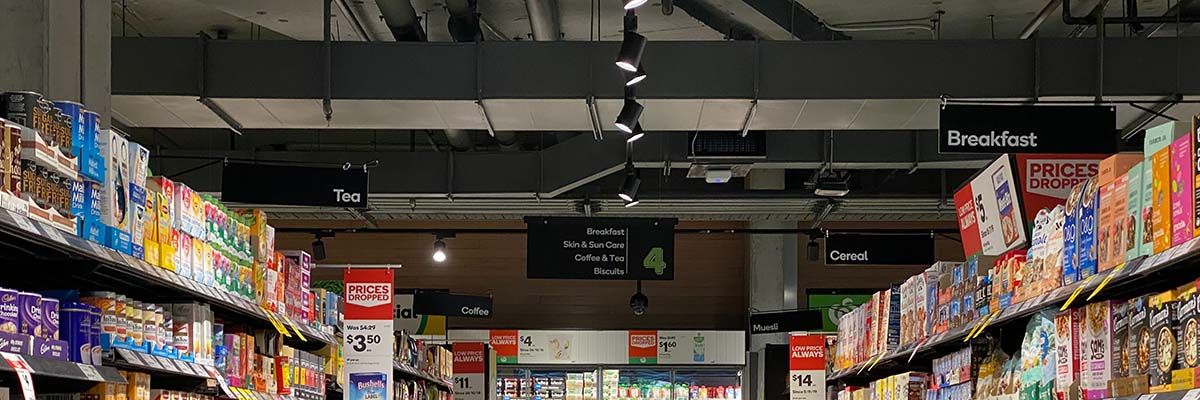
The HVAC challenge for grocery and convenience stores
HVACs are essential for grocery and convenience stores – let’s explore what that means. As you may recall, different facility-types present different heating, cooling, and ventilating requirements. Nowhere is that clearer than in the unique and complex demands of grocery and convenience stores.
Why unique? According to the US Government program Energy Star[1], supermarkets use around 50 kilowatt-hours (kWh) of electricity and 50 cubic feet of natural gas per square foot per year — an average annual energy cost of more than $4 per square foot. Translated, that means an average sized store of around 50,000 square feet will generate energy costs of around $200,000 annually.
That’s roughly five times more than any other facility type. With those numbers in mind and considering that supermarkets tend to operate on very small financial margins, the importance of getting HVAC right (or perhaps optimized is a better word here), is fundamental.
A complex challenge
Let’s look at the challenge more broadly, beyond just the biggest supermarket-type stores. The predominant issue heating and ventilating these sorts of businesses is their inherent complexity. These stores have a diverse range of HVAC needs. Unlike other businesses, supermarkets have many diverse zones where factors such as humidity and temperature must be precisely balanced to extend product life and yet still provide shopper comfort.
Put another way, grocery and convenience stores place a broad range of different commercial applications under a single roof. These include HVAC to heat and cool individual spaces and handle ventilation; refrigerated units for specific products that drive a steady stream of cooled air then discharged into the facility, cooking equipment that ejects heat which must then be ventilated, and more. Together, they drive ever fluctuating HVAC loads which must be addressed throughout the day.
Fluctuating loads must be managed with agility
It's the management of these loads that’s the pivotal aspect of HVAC system design and optimization, and, in particular, addressing the question of how they can be optimized to save energy. Not surprisingly, a number of different challenges come into play.
For instance, as a result of the physical in-store elements stated above (particularly refrigeration units), it’s easy to fall into the trap of over-sizing HVACs. It’s also possible to overlook the reality that ventilation will in many cases be the major source of moisture that negatively affects some products. This means treating outdoor air before it comes into the store should be a focal part of an optimization or energy management strategy.
Alternative solution approaches abound
With all this in mind, what are the options when it comes to HVAC solutions for this domain? As you might expect, there’s a broad range but here are some key alternatives:
Air Curtain HVACs
You probably know the wave of cold or hot air (depending on the time of year) that hits you when you walk into a store. That’s an air curtain, usually hanging above a doorway though sometimes embedded into a ceiling. Air curtain HVACs create a barrier between the interior and exterior air, preventing so far as possible the two from mixing and also reducing dust, dirt, and insect issues.
Rooftop Units (RTUs)
Located, predictably, on store roofs and in numbers dictated by the size of the facility (the bigger it is, the more units will be needed), RTUs provide a fully packaged system where all components (fans, compressors, heat exchangers, etc.) exist inside one “box” to condition the space.
Air handling units (AHUs)
Air Handling Units have a similar form factor to RTUs, but they differ by being driven by chillers and boilers rather than having built in DX compressors and gas heat exchangers. Typically, multiple AHUs are served by the same chiller and boiler.
VRF systems
These use variable speed compressors allied to sensors and electronic controls to vary refrigerant flows to match cooling requirements. These systems have the advantage of being able to manage multiple locations within the facility simultaneously, according to the requirements of each.
There are, as noted, many more alternative HVACs: Fan Coil Units, Extract ventilation, Split Air Conditioning, Heat Pumps, and Heat Recovery Systems among others all come into the equation.
Flies in the ointment
With grocery and convenience stores, there’s another fly in the HVAC ointment beyond system choice that needs to be considered too. That’s the question of food storage. Though the size of the store will determine the extent of the requirement, these facilities will all have refrigeration systems of some size that include condensers and compressors to remove extra unwanted heat from food areas and have to be weighed up as part of the HVAC design and optimization equation.
And, of course, size matters. The larger the store, broadly, the more complex its energy management needs are likely to be. Will booster systems be requirement for specific areas within the store where refrigeration or freezer units are placed? Will a secondary compressor be required to augment the HVAC system? How will everything be controlled and optimized?
Optimize with NexRev
Clearly, the question of HVAC and energy management for grocery and convenience stores is a complex one and, in this blog, we’ve only touched on some of the key considerations and options for addressing them. The right steps in each specific case require expert advice and analysis. We cannot over-stress that.
At NexRev, we’ve been unlocking the power in facility and energy management data with over a million connected devices across North America. We deliver optimized HVAC performance, though our DrivePak solutions – adopted by leading grocery and convenience store chains across America.
Our team of experts are focused on helping you deliver more with your budgets, infrastructure, and assets to create sustainable savings in operations and energy, reducing your risk and increasing operational confidence.
If you’re interested in learning more about our solutions can help your business reduce energy costs by optimizing your HVACs (and much more!), please send an email to:
[1]https://www.energystar.gov/sites/default/files/buildings/tools/SPP%20Sales%20Flyer%20for%20Supermarkets%20and%20Grocery%20Stores.pdf